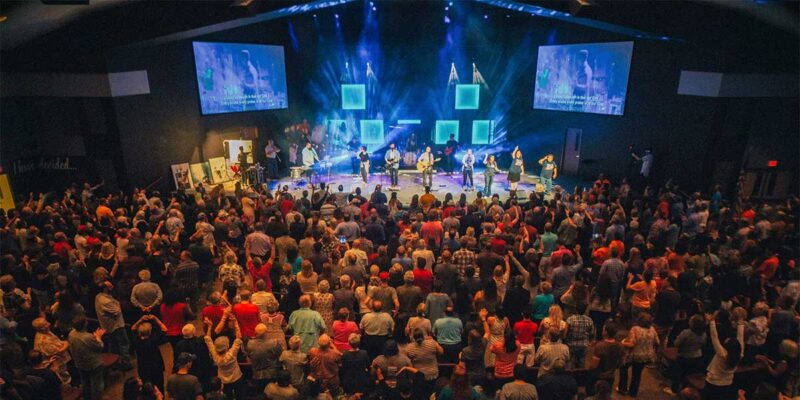Cost Savings vs. Stewardship: Tech Buying in Churches
 There is a saying that churches buy a sound system three times. The first is the one the building “comes with” that was most likely designed by the general contractor or a local music store. A well-meaning but ill-experienced volunteer who adds some new equipment typically installs the second system. The third system is usually the result of the church leadership (and members) being tired of the problems. A consultant or design/build A/V firm normally designs this third system and does it right.
There is a saying that churches buy a sound system three times. The first is the one the building “comes with” that was most likely designed by the general contractor or a local music store. A well-meaning but ill-experienced volunteer who adds some new equipment typically installs the second system. The third system is usually the result of the church leadership (and members) being tired of the problems. A consultant or design/build A/V firm normally designs this third system and does it right.
The Online Price Bait & Phone Sales
This first type of mistake isn’t the fault of the Internet. It’s the mind-set that brings about this type of purchase: determining budgets before assessing needs (or even knowing how). Not knowing how to determine the right projector and associated hardware leads to wasted money and frustrated viewers.
In my years of design/build and then consulting churches, the story is almost always the same. They shop the model number or even a ‘system price’ (why do some systems integrators do this?) and go for the lowest price. What they fail to realize is that while it’s possible to buy cheap for a commodity item, the cost of ownership isn’t calculated into the price. What was a ‘good price’ is potentially a poor value.
Similarly, you simply shouldn’t sell a system over the phone. It’s impossible to know what the church needs, what the environmental factors are in the building, or what kind of structural or electrical limitations exist. A site-survey is in order.
Sure, someone can ask good questions, but unless the church knows what kind of light meter readings to take, what how to measure the acoustics of a room, what type of cabling and infrastructure are present, they’re really just skimming the surface. I have yet to find a church that has had a system sold to them over the phone that was even remotely close to what the church needed. And, yet, I find advertisements to churches that say things like:
“[Company name here] is the leading provider of multimedia equipment to the religious market.” — How can they even begin to back that statement up, factually?
“Brilliant, vivid projection even in normal room light.” — Because sunlight is equal in every room on every size screen? I actually found this advertisement pitched by a Christian bookstore — obvious projection experts.
I’m amazed that a few of these “church A/V firms” are still in business. One, in particular, is infamous in our industry for poorly designed systems. Yet, they’re still in business. How is this possible? The answer is that a shockingly large (majority?) percentage of churches don’t check references. At all. How hard is this? Promote your list of references! Encourage them to make those calls.
When Churches Buy Too Fast
If a church is not a fast-growth with lots of A/V/L projects happening repeatedly, chances are they’re not going to be up-to-speed when it comes to knowing what’s now possible since their last system was installed (a decade or more ago). This can lead to last minute, we-need-it-fast purchases.
Generally speaking, entire system upgrades happen for three reasons in churches:
1) New building program
2) Renovation of existing building
3) Expanding to a new multi-site campus
If a church is about to begin new construction, build relationships with the architects and general contractors in your town. Implementing the A/V/L design at this stage will save the church thousands of dollars down the road as important infrastructure such as conduit, power runs, screen placement, speaker weight loads, control point access, lighting fixture hang points, and wall plate and floor box locations that affect A/V/L design will be mapped out early on in the process (and is a cost-savings on change orders, too).
Well-meaning architects want a pretty space, but marrying form with function isn’t an easy process. I’ve been brought in countless times after a building was mostly constructed, only to find out that we couldn’t move the screens to the correct location because large steel I-beams are irrevocably in the way, or no conduit was run to key positions. Your value to churches at the beginning of the process will save them money and even building delays by the mistakes that are not made. This isn’t even a sales-pitch; this is just the truth.
If a church is in the renovation process, the same is true: Earlier is better. Be the experts and a champion for the church. You fight the battles with electricians, GC’s, and architects for the right A/V/L infrastructure to allow the church to have flexibility with technology long after the remodel is completed.
And, if a church is just beginning to use dive deep with A/V/L, work with them to not only recommend equipment, but also train their volunteers and staff on the operation and ongoing maintenance. Heck, position the service contract and contract labor options to help them get ramped up and running smoothly long after the installation is complete.
Let churches know you will help them to create a unified system, and give them a clear upgrade path for growth. With the desired outcomes defined, the system will have a value that is greater than the sum of the line item pricing.
Good Stewardship Usually Isn’t Low Cost
One of the truths I’ve taught for nearly two decades is that churches are spending money that comes from the sacrifice of the congregation; as such, being a good steward is key. Because of this, more than a few churches associate good stewardship with cost savings. But if a church saves some money on a cheap system that doesn’t meet their needs, it’s just a matter of time before they have to buy more (or replace what didn’t work). There’s even situations where a church buys a system three times before they finally spent money on what actually worked for their ministry. That is the antithesis of good stewardship.
Good stewardship is less about how much money was saved, and more about how much money wasn’t wasted. Buy a system three times? Yeah, that’s not good stewardship.
Help churches be good stewards. Sell them value, and let price be what it is: the summation of what it takes to create their desired outcome.
Share your views and opinions in the comments below and be sure to click the share buttons for social media to put this in front of your church clients.





